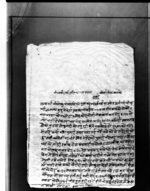A purjī from the Guṭhī Bandobasta Aḍḍā to the Kausī Tosākhānā requesting the disbursement of funds for installing a new Kumārī (VS 1980)
ID: K_0214_0047
Edited by
Astrid Zotter
in collaboration with
Raju Rimal
Created: 2018-10-25;
Last modified: 2019-06-05
For the metadata of the document, click here
The accompanying edition, translation/synopsis and/or commentary are available under the terms of the Creative Commons Attribution-ShareAlike 4.0 International License
Abstract
This purjī issued by the Guṭhī Bandobasta Aḍḍā supports the claim of the pūjārī Vimalāramaṇa Rājopādhyā to material provisions for installing a new Kumārī in time to be worshipped during Baḍādasaĩ at the Patan Taleju temple as being a rightful one. The Kausī Tosākhānā is requested to disburse 9.25 Rs. for clothing.Diplomatic edition
[1r]
1⟪13⟫1श्री५सर्कारतर्फगुठीवन्दोवस्तअडावा कौसीतोसाषानाके2पुर्जी
3उप्रान्तपाटंश्रीतलेज्युमावडाडसैको•पुजामारअरुपर्वपर्वमास्मेतपुजागर्नश्रीकु
4मारी७६साल्काषुन्भैफेर्डागुलवंडाकोलहंगा११।पत्तातीनषापकोचोलो१
5लालवपडाकोपछ्यौरा१स्मेत्कोरकौसीतोसाषानावातमोरु९।२५भो
6ज्कोचाहीनेठेकडारवातमोरु२०।स्मेतज्मामोरु२९।२५षर्चगरीस्थापनाभ
7येकोमाहालसोकुमारीकोडाट्झरीषुनभय़ाकोलेय़ो८०साल्कोवडाड
8सैलाईअर्कोनञाकुमारीस्थापनागर्नुपर्नेभये़कोलेजाहेरगरेको
9 छुसावीक वमोजीं पाउं भंने स्मेत वेहोराको पुजारीवीसलारमणराजोपा
10ध्याको जाहेरी डर्षाष् ये़सअडामाडीय़कोलेवुझडाडर्षाष्कावेहोरा
11वातपोसाक्वापतमोरु९।२५तेसअडावातपाये़कोभंन्यलेषिय़कोदे
12षिनालेसोडर्षास्तवमोजींकोषर्चचाहीनेमध्येतेसअडावातपाउ
13नेभनीलेषिय़ाकोहोमोरु९।२५कोहरुव़ालेषनेकांभय़कोछतस
14र्थमाटीलेषिय़ाकोव्येहोरावुझीसोकुमाफेर्दालेषिय़वमोजींपोसा
15ककेमोरु९।२५तेसअडावातजानेडरवंडीसनभये़हालषुनभैअ
16र्कोकुसपीस्थापनागर्नालाईपनीमोरु९।२५नौरुपैञापचीसपैसाऐं
17सव़ालकोरीतपुर्याईनीजपुजाहारीहस्तेडीनेकांभयावेसहोलासं८०सा
18लआश्वीं गतेरोज शुभ्म्¯¯¯¯¯¯¯¯¯
Synopsis
[1r]
This purjī is issued by the Guṭhī Bandobasta Aḍḍā under Śrī 5 Sarkāra and is addressed to the Kausī Tosākhānā.
It quotes an application (darkhāsta) by the pujārīVīmalāramaṇa Rājopādhyā in connection with material provisions needed for installing a new Kumārī. The sum applied for amounts to 29.25 mo[hara]rū[paiyā̃]s, including 9.25 morus for clothing, to be provided by the Kausī Tosākhānā, and 20 morus for the attendant feast, to be provided by contractors (ṭhekadāra). The application quoted gives as the reason why a new Kumārī needs to be installed the fact that the present one, installed in VS 1976 with the same sums being spent, shed blood while losing a tooth. As the Kumārī was worshipped during the autumnal Dasaĩ festival at the Pāṭaṃ Śrī Talejyū [temple], a new Kumārī needed to be installed before the upcoming Baḍādasaĩ of VS 1980.
The darkhāsta quoted is supported as being in accordance with the usual practice. The applicant's claim to receive the 9.25 morus for clothing is forwarded to the Kausī Tosākhānā with a request to disburse these funds.
Commentary
This document seems to have been copied from document K_0214_0045. Strong indications of this are reading mistakes that seem to be the direct result of misinterpretations of the text as written down in the latter document. In line 4 the unclear script in K_0214_0045 invites the reading 11 । pattā for 1 vāpatta, in l. 13 ho for so and haruvā (or something similar) for hakamā, in l. 16 kusapī for kumārī. The only differences that cannot be related to K_0214_0045 are an addition of aḍā after guṭhī vandovasta (l.1) and the rendering of pujārī as pujāhārī in line 17. These do not, however, mitigate against the assumption that this is a direct copy, as both modifications could have easily been made by an office scribe. In copying, the scribe of the present document retained the writing of ḍa for da, as done in K_0214_0045, but corrected that of ṭa for ta. The latter correction has resulted in the "overcorrected" rendering of the postposition -vāṭa as -vāta (ll. 5, 6, 11, 14). Among other mistakes, the present scribe's tendency to omit akṣaras (ll. 1, 14, 15) is worth noting.
For a translation and further comments, see the Commentary to K_0214_0045. For further thoughts on the case in question, see the Commentary to K_0214_0044.

